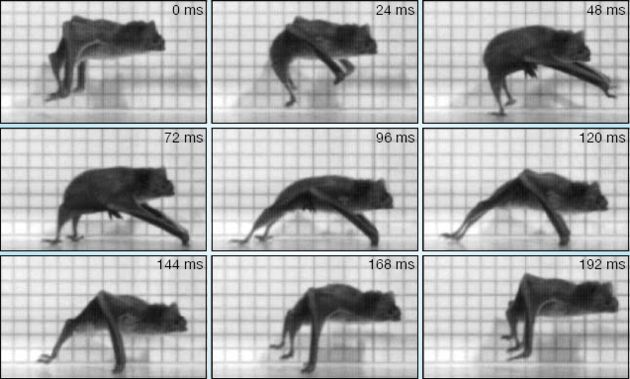Yikes! Vampire Bats Can Run, Too

As if nature really needed to endow vampire bats with anything more unusual than the ability to fly and a propensity to drink blood, the creatures have been found to sprint along the ground, too.
All the better to sneak up on a victim, scientists say.
A new study found fleet-footed vampire bats can break into a loping run on all fours, at least when coaxed on a treadmill.
Bad news for cows
Bats are the only mammals the fly. Scientists think they generally stopped running long ago, as evolution gave flight capabilities to their forelimbs. Most species of bats, if asked to run, can do little more than flop around like fish out of water.
Vampire bats must have regained the ability to run, says Cornell University researcher Daniel Riskin, who led the new experiments. The skill might have been useful for chasing down small, swift animals that wouldn't sit still for a feeding event, Riskin told LiveScience.
Sign up for the Live Science daily newsletter now
Get the world’s most fascinating discoveries delivered straight to your inbox.
Thing is, the common vampire bat rarely chases small animals anymore. Instead, it feeds mostly on dosing cattle that have been introduced into the bats' range -- mostly from northern Mexico down to Argentina and Chile -- over the past few hundred years, Riskin said. In labs, a vampire bat will feed on anything -- even a snake -- but in the wild they prefer cows, whose blood they drink mostly at night while the livestock sleep.
"Cows just seem to be the easiest," he said.
The ability to run is not so critical when gorging on a sleeping cow, and therefore it has gone unnoticed by scientists, Riskin figures.
Hopping is good, when you're a bat slurping cow blood, because cows are heavy and can kick or roll over and squash a bat, Riskin explained in a telephone interview.
On to the treadmill
Scientists knew previously that the legs of vampires were stronger than those of other bats, enabling them to crawl and hop. In the March 17 issue of the journal Nature, Riskin and his colleagues write: "The common vampire bat (Desmodus rotundus) walks forwards, sideways and backwards, and initiates flight with a single vertical jump from standing." Researchers still don't know exactly why they can walk.
And nobody had ever documented bats doing the 4-yard dash.
To study this movement, captive bats were put on a treadmill -- safely inside a Plexiglas cage -- and photographed. At slow treadmill speeds, the bats walked in a manner similar to mice. When the treadmill was cranked up, the clever little mammals dutifully kept pace, using mostly their powerful forelimbs to reach speeds exceeding 2.7 miles per hour (1.2 meters per second).
"Bats with a little more room to maneuver can probably move twice that fast," Riskin said.
For the record, a reasonably fit human can run much more quickly.
The swift gait of the vampire bat is unlike that of any other animal, the study found. The scientists call it running "because it includes a notable aerial phase." You might want to jog across the room with a nice spring in your step to understand what that means.
Vampire bats, it seems, are over-evolved, now that their prey are just lumbering cattle.
"It's as if they were designed to chase race cars," Riskin said, "and they find themselves running after school buses."
Bat on a Treadmill
Credit: D. Riskin; Nature
Escape Velocity
Top speeds in mph:
Blood Suckers?
((ImgTag||right|null|null|null|false)) A vampire bat hangs out at the Philadelphia Zoo. AP Photo
A vampire bat's wingspan is typically 8 inches, though its body is about the size of an adult human thumb. It feeds on the blood of horses, pigs and even birds. The common vampire bat, Desmodus rotundus, prefers cows, however.
The vampire hunts at night, when other animals are sleeping. It doesn't suck blood. It uses heat sensors to find a victim's veins. Sharp teeth cut the animal -- about like a shaving nick -- and the bat simply laps up what oozes out.
A chemical in the bat's saliva keep the blood from clotting, so it keeps flowing (a blood-thinning drug developed from vampire bat saliva helps prevent strokes and heart attacks). Another chemical numbs the victim's skin so it won't wake up.
"They sit there licking the wound for up to a half hour," says Daniel Riskin of Cornell University. A bat will drink about a tablespoon of blood in a sitting.
Vampires have attacked humans, but such reports are rare.
Robert Roy Britt, LiveScience SOURCE: Daniel Riskin, Cornell U.; Wildlife Trust; Woodland Park Zoo in Seattle; Cincinnati Zoo
Robert is an independent health and science journalist and writer based in Phoenix, Arizona. He is a former editor-in-chief of Live Science with over 20 years of experience as a reporter and editor. He has worked on websites such as Space.com and Tom's Guide, and is a contributor on Medium, covering how we age and how to optimize the mind and body through time. He has a journalism degree from Humboldt State University in California.











